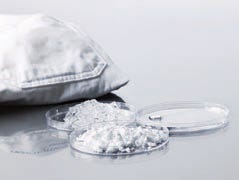November 30, 2011
Intrinsically biocompatible, biodegradable, and biologically functional, hyaluronic acid (hyaluronan) is used in a range of medical device applications. However, because it has traditionally been synthesized from either rooster combs or various attenuated strains of Streptococcus, it can incorporate animal-derived contaminants or immunogenic pathogens. Now, in a break with tradition, Novozymes Biopharma offers a grade of hyaluronan that avoids these pitfalls.
|
Made without animal or Streptococcus-derived materials, Hyasis does not expose patients to contaminants or pathogens. |
In contrast to standard hyaluronan, Novozymes' Hyasis is produced in a fermentation process involving a nonpathogenic bacterial host called Bacillus subtilis, explains Hans Ole Klingenberg, the company's global marketing director. Because it is not derived from Streptococci, it does not expose patients to toxin-secreting pathogens that can result in hemolysis. In addition, it is processed without organic solvents, ensuring high purity and reducing contamination.
Hyasis's porosity and the reduced size of its spray-dried particles enable it to dissolve up to five times faster than other hyaluronan materials, reducing its filtration time and manufacturing costs, Klingenberg says. Given its purity, the material can also be autoclaved without losing significant molecular weight and viscosity. And because its Bacillus-based fabrication process produces material with a targeted molecular weight and narrow polydispersity, manufacturers can avoid process variability, according to Klingenberg.
"Hyaluronan is a naturally occurring polysaccharide that is distributed widely throughout connective, epithelial, and neural tissues," Klingenberg says. "By providing structure to tissues--including skin and cartilage--it contributes to the optimal functioning of the body, acting as a binding and protecting agent in tissue hydration and lubrication." By supplementing the natural levels of glycosaminoglycan in the human body, Klingenberg adds, hyaluronan is suitable for use in a variety of drug-delivery and medical device applications.
While hyaluronan is often used in osteoarthritis applications to supplement naturally occurring hyaluronan, it also serves as a component in implantable devices or in viscoelastic devices during the removal of the natural lens of the eye. In other applications, Klingenberg notes, it is used as a coating because it exhibits low surface friction. Applied by dip-coating, hyaluronan can be deposited on both the inside and outside surfaces of medical devices and on most commonly used polymers and metals.
"The widening use of hyaluronan in medical device applications can be explained by its moisturization properties and its ability to promote tissue healing," Klingenberg says. "And Hyasis is redefining hyaluronan because it enables customers to improve how the material is processed and formulated, speeding up product development and creating improved therapies."
Novozymes Biopharma
Bagsvaerd, Denmark
You May Also Like



